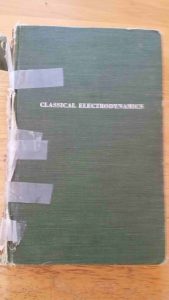I add a series of notebooks on classical mechanics. This series was motivated by a close reading and problem-solving project I undertook in 2014. The focus of my attention was the text Introduction to Classical Mechanics with Problems and Solutions, by David Morin. I focus on generating notebooks on selected topics covered in Chapter 9 Angular Momentum, Part II (General L), which deals with 3-D rigid body dynamics.
Blog
New Notebook
I add a notebook detailing calculations performed in the analysis of Kelvin ship waves. This is a classic problem and a long time favorite of mine.
Notebooks for fluid mechanics exercises from Modern Classical Physics
I add 12 notebooks related to exercises in Chapter 13, Foundations of Fluid Mechanics, of Modern Classical Mechanics, Kip S. Thorne and Roger D. Blandford. This is a wonderful new physics book that will become a classic. I heartily recommend that all physicists purchase this book. In particular, I focus on fluid mechanics topics that I did not cover when I was a working physicist.
New notebook on plasma kinetic theory
I add the plasma physics related notebook Electrostatic response – warm magnetized plasma 12-12-17. This constitutes a new take on a problem area that motivated my interest in symbolic computing many years ago. I demonstrate how contemporary Mathematica capabilities can be used to facilitate calculations in the kinetic theory of plasma physics.
Both the .pdf and .nb forms of the notebook are free to download.
New notebooks on Jackson’s Classical Electrodynamics

I add four notebooks treating topics in J. D. Jackson’s Classical Electrodynamics, the textbook from which I learned electricity and magnetism. This is a notoriously difficult text that has caused pain for generations of physics graduate students. Frankly, modern texts provide a better introduction to the subject (read the Amazon reviews on Jackson). But, if you do the math in Jackson and solve the problems, you will have developed a repertoire of technical skills that will serve you well as a theoretical physicist.
I enjoyed reviewing Jackson and working through some of the examples in detail. It took more time than I expected and made me realize I just skimmed the surface when I was a student facing the pressure of other classes. My second objective in generating these notebooks was to make use of my experience with Mathematica to perform as many of the derivations and calculations as possible using symbolic manipulation. This also was more difficult than I expected. The standard physics notation for electrodynamics is intricate and highly decorated and effort must be expended to approximate it. One must also manipulate expressions involving multiple integrals and summations and control the order of their evaluation. Numerical methods must be developed for testing approximate analytical results. Just the development of relevant visualizations is nontrivial.
I cover only a small fraction of the subject material in Jackson. I focus on electrostatic problems (first three chapters of Jackson) and limit my consideration to derivations and examples involving spherical symmetry. There is MUCH more I could do. I plan to add more notebooks as time permits.
New notebook on Poisson processes
I’ve had an opportunity to finish up a notebook on Poisson processes –
17-41 Poisson process problems 07-12-17 and add it to the Math/Probability and Statistics section. The blurb is
I present a number of calculations and problem solutions featuring Poisson Processes. The basic Poisson process is visualized and derived three different ways. Twenty-three different problems involving Poisson processes are solved. Most solutions make use of Mathematica Probability capabilities with analytic solutions often cross-checked against simulation.
This is a Poisson process analog of the Bernoulli process problem collection – 17-4 Dice Probabilities 02-26-16.
Website launch
After much incremental learning, trial and error, and practice concerning WordPress, website design, and related issues – I am ready to launch this personal website. Most of the material in this initial release was originally implemented in a “developmental environment” on my local computer using a software system – DesktopServer by ServerPress.com, a development tool that I highly recommend.
I initiate the website with a collection of about 40 Mathematica notebooks on topics in three main areas – Physics, Quantitative Finance and Math. Under tabs Home and About, I provide some background and discuss my intentions for this website. Under the tab Guidelines I provide some background to my Mathematica programming style as well as example notebooks that can be downloaded either as a pdf file and viewed or as a notebook file (.nb) and executed in your version of Mathematica.
If you want to make use of material on this website, you should follow the instructions on the Guidelines page and download the example notebook files to test that they successfully execute on your personal system. If the example .nb files don’t execute, none of the other specialized .nb files will either.
After some deliberation, I decided to not open this blog to comments. I simply don’t have the time or inclination to deal with the administration of spam, arguments, and flames I observe on other blogs. If you wish to comment please send me an email. When time and circumstances permit, I will respond.
I expect to be adding much more material to this site. When new notebooks are added or changes are made, I will provide notification in the form of a blog entry.